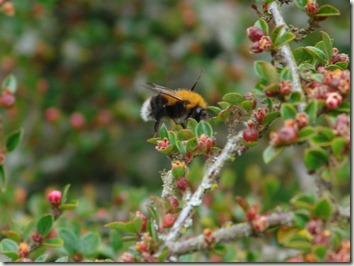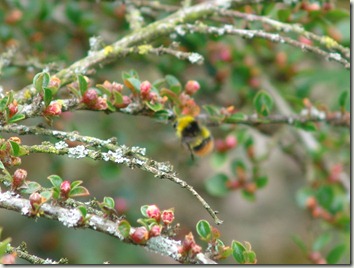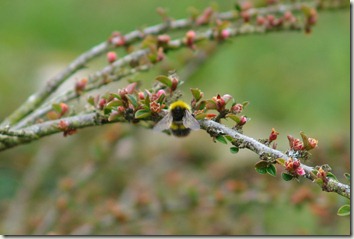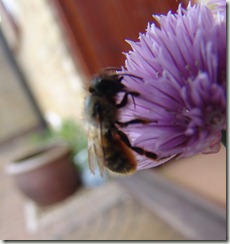The Natural History Museum list six bumblebees, “The Big Six” as being the most common bumble bees in the UK. But I think very soon they will have to add another because although this pretty bee is a relative newcomer to the UK, it is spreading fast. It’s the Tree Bumble Bee, Bombus hypnorum which was first recorded in the UK in 2001.
It has very distinctive colouring, a ginger thorax and a black abdomen with a bright white tail. Someone said it looks as though it has been dipped in white paint..it’s true.
B Hypnorum colour key from Paul Williams great interactive bee identification charts at the Natural History Museum here.
I saw it last year in London and I have seen them everywhere I have been this year.
First in Dad’s garden in March. Then at Easton on the 15th April buzzing around the plum blossom on a sunny wall.
B hypnorum Easton Walled Garden, photo Val Littlewood
Then today I walked up to the Church in the village and saw one feeding on an arching bony cotoneaster, its flowers barely noticeable, which was crouching over one of the old graves there.
It’s a lovely and slightly unkempt churchyard. I like to wander around there. The wild flowers and unmown areas are great for bees.
The hypnorum above, accommodatingly showing its pretty white painted tail, was waving a warning leg at a little B Pratorum who had come too close.
The diminutive flowers of the cotoneaster were humming with them. They are tiny and so bright, a brilliant acid yellow as opposed to the tawny yellow of the hypnorum. I wonder if they are newly hatched. They were very busy and whizzed about rather too quickly for me to get a good photo.
Bombus pratorum on cotoneaster, Grafham Churchyard
They are really delightful little bees. I had planned to get a painting of the Hypnorum done for this summer’s shows because people will be able to see them in many areas of the UK and they are very pretty. I have just sketched it out for now and plan to show it feeding on the early plum blossom at Easton.
Easton Hypnorum sketch
Meanwhile the Humming Cottage here is still humming, but our charming little Osmia rufa mason bees are slowing down. A few faded and balding bees are still getting into the house. I put them on the chives outside the back door.
They bury their heads in the flowers and then, suitable revived, fly off.
I will miss them.













Fantastic sketch! The angle's perfect, can't wait to see it colored! Funny how some people worry so much about some bees disappearing, I think there will always be new species emerging, the spotlight will shift . . still, it's important to do what we can to preserve the present bees, and for that cause, you're doing a marvelous job here with your work!
Badges
Your drawings and photographs are such a source of delight! Thank you for sharing them.
I try to watch out for our native bees, every day.